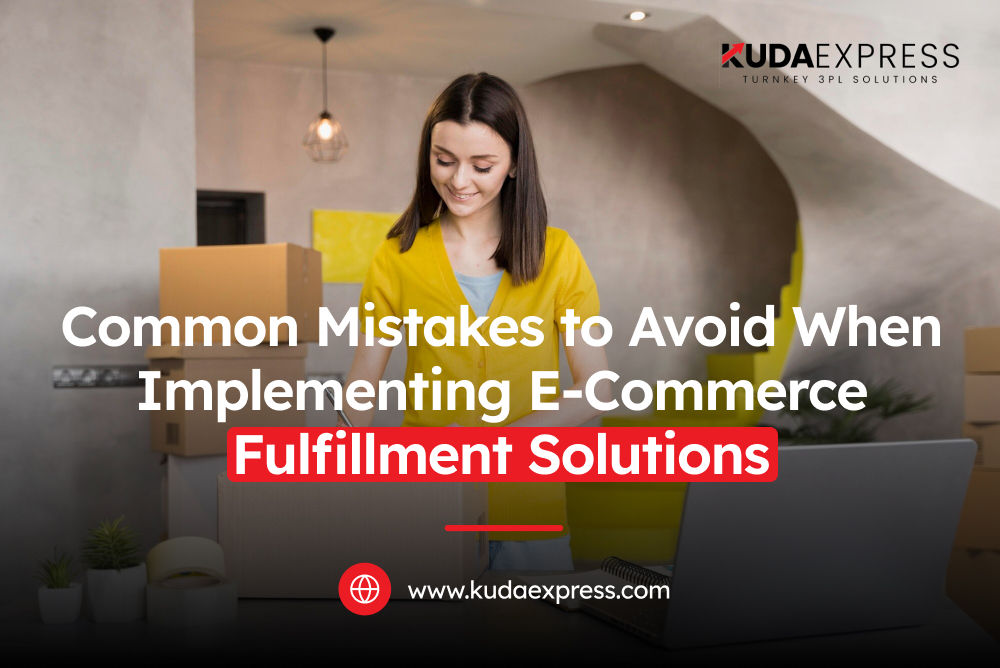Common Mistakes to Avoid When Implementing E-Commerce Fulfillment Solutions
As e-commerce continues to expand, the need for efficient and reliable fulfillment solutions becomes increasingly crucial for businesses looking to thrive online. Implementing an effective e-commerce fulfillment strategy can drastically improve customer satisfaction, reduce operational costs, and boost overall efficiency. However, the road to achieving a streamlined fulfillment process is often paved with potential pitfalls. At Kuda Express, we've seen firsthand the common mistakes businesses make when setting up their e-commerce fulfillment operations. Here, we outline these mistakes and provide guidance on how to avoid them, ensuring your fulfillment strategy supports your business goals effectively.
1. Underestimating the Complexity of E-Commerce Fulfillment
One of the most frequent errors businesses make is underestimating how complex fulfillment operations can be. E-commerce fulfillment isn’t just about shipping products; it involves inventory management, warehousing, packing, shipping, handling returns, and customer service.
Avoidance Tip: Partner with a fulfillment expert like Kuda Express who understands the intricacies of the entire process. Leveraging experienced professionals can help streamline your operations and avoid costly mistakes that can arise from misunderstandings of the complexities involved.
2. Neglecting Proper Inventory Management
Inadequate inventory management can lead to stockouts, overstock, and, ultimately, cash flow problems. Many businesses fail to synchronize their inventory with their sales data, leading to discrepancies that can affect order fulfillment.
Avoidance Tip: Implement robust inventory management systems that integrate seamlessly with all your sales channels. Real-time inventory tracking helps maintain accurate stock levels, reduces the risk of selling products that aren’t in stock, and ensures timely reorder of inventory.
3. Choosing the Wrong Technology
Selecting inappropriate or outdated technology can hinder your ability to efficiently manage e-commerce fulfillment. Some businesses stick with manual processes or disjointed systems that do not scale well or integrate poorly with other technologies they use.
Avoidance Tip: Invest in scalable, integrated technology solutions designed for e-commerce fulfillment. Look for systems that can grow with your business, provide comprehensive analytics, and integrate smoothly with your existing e-commerce platforms and ERP systems.
4. Ignoring the Importance of Packaging
Packaging plays a crucial role in not only protecting your products during transit but also in branding and customer experience. Poor packaging can lead to damaged goods and dissatisfied customers, which in turn can affect your brand reputation.
Avoidance Tip: Design packaging that is both functional and representative of your brand. Consider environmentally friendly options that appeal to eco-conscious consumers. Ensure that the packaging is robust enough to protect the contents but not excessively bulky or expensive.
5. Overlooking Return Policies and Processes
Having a cumbersome returns process can deter customers from shopping with you again. The returns process is a crucial aspect of customer service in e-commerce and can be a complex area to manage efficiently.
Avoidance Tip: Create a clear, concise returns policy that is easy for customers to understand and just as easy for them to execute. Use a fulfillment partner like Kuda Express to manage returns smoothly, ensuring that they are processed quickly to maintain customer satisfaction and inventory accuracy.
6. Failing to Plan for Growth
Many businesses do not consider how their fulfillment strategy will scale with their growth ambitions. They might manage fulfillment in-house at the start, but as order volumes increase, this approach can quickly become unsustainable.
Avoidance Tip: Develop a scalable fulfillment strategy from the beginning. Consider factors such as increased order volumes, seasonal fluctuations, and potential market expansions. Choosing a fulfillment partner like Kuda Express can offer flexible solutions that scale with your business needs.
7. Inadequate Customer Communication
Communication is key in maintaining customer satisfaction. A common mistake businesses make is not keeping customers informed about the status of their orders, which can lead to frustration and negative reviews.
Avoidance Tip: Ensure that your fulfillment solution includes options for automatic updates at every stage of the fulfillment process, from order confirmation to delivery tracking. This not only improves customer experience but also reduces the workload on your customer service team by minimizing inquiry calls and emails.
8. Not Leveraging Data and Analytics
Data is a powerful tool in optimizing e-commerce fulfillment. However, not utilizing the data to analyze and improve operations is a missed opportunity for many businesses.
Avoidance Tip: Utilize analytics to monitor key performance indicators (KPIs) such as order accuracy, shipping times, and return rates. Use this data to identify areas for improvement, make informed decisions, and optimize your fulfillment processes.
Conclusion
Avoiding these common mistakes when implementing an e-commerce fulfillment solution can save your business time, money, and a lot of potential headaches. By understanding the complexities, investing in the right technology, planning for growth, and maintaining clear communication with customers, you can establish a fulfillment process that not only meets but exceeds customer expectations. Partnering with an experienced fulfillment provider like Kuda Express can further enhance your capabilities, providing you with expert advice, cutting-edge technology, and scalable solutions tailored to your business needs. Take your e-commerce operations to the next level by ensuring your fulfillment strategy is up to the task.

